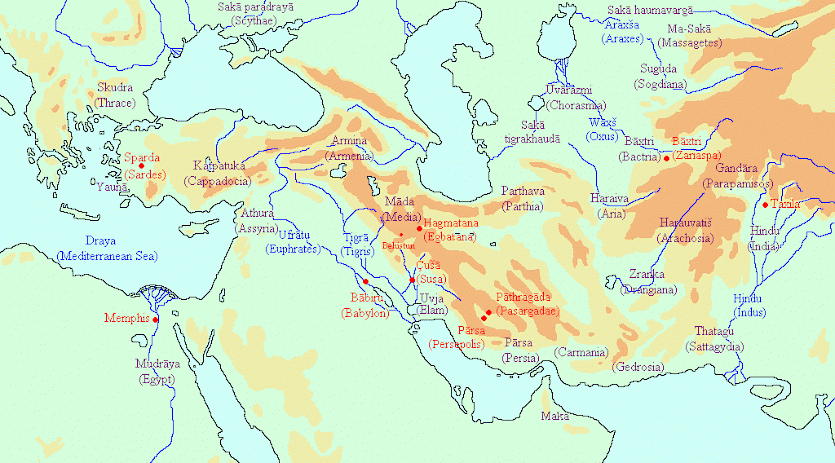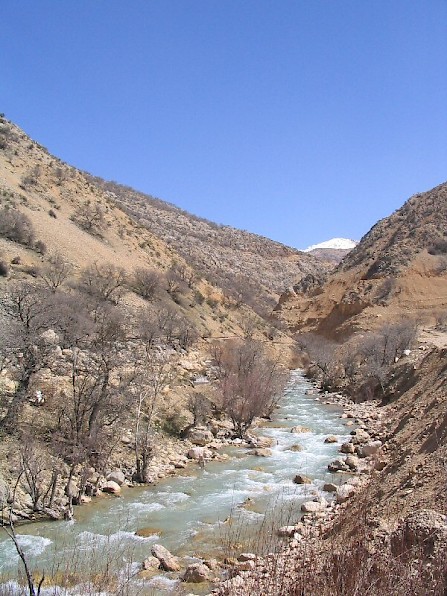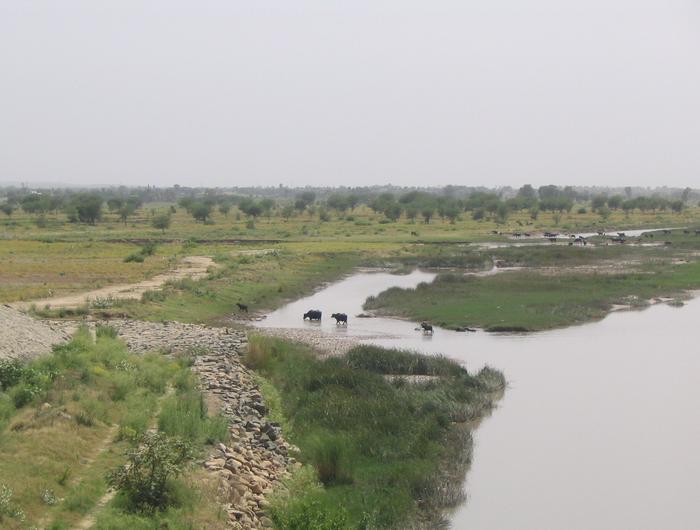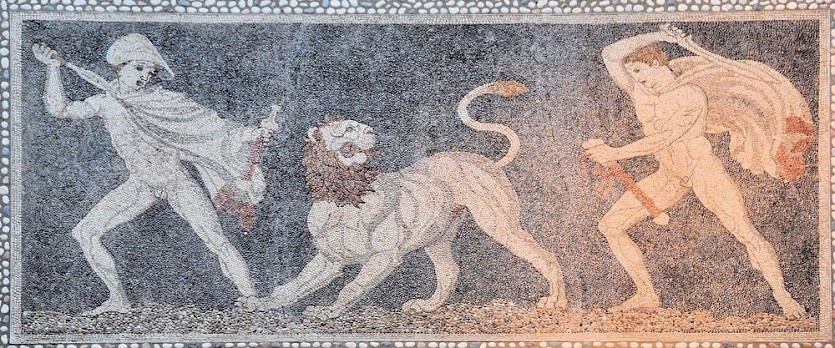Craterus
Craterus (†320): Macedonian army commander, one of the leading generals of Alexander the Great.

Craterus was born as the son of a Macedonian nobleman named Alexander, in Orestis (the mountainous 'lake district' between modern Greece and Albania). His career started as commander of one of the phalanx brigades. In this capacity, he was present during the battle near the river Granicus (June 334), where Alexander and Parmenion defeated the Persian satraps of Asia Minor.
He must have been a capable commander (or knew how to deal with his king), because in November 333, during the battle near Issus (text), he commanded not only his own brigade, but the complete phalanx and all infantry on the left wing. This meant that only Parmenion, the commander of the left wing as a whole, was between him and Alexander.
During the naval attack on Tyre, he commanded the ships on the left wing. Probably, this was because Parmenion was away; there are no indications that Craterus had surpassed his former superior, because during the battle of Gaugamela (1 October 331), Craterus was again Parmenion's inferior. During this battle, he was, again, commander of a phalanx battalion, of the phalanx and all infantry on the left wing (more).

In the last weeks of 331, Craterus is mentioned in two fights during the invasion of Persia proper (against the Uxians and near the Persian gate). In both cases, he and Alexander are the supreme commanders. The same happened during the pursuit of the Persian king Darius III: Alexander commanded the vanguard, Craterus the main body of the army (early July 330). During the war in Hyrcania, he was sent on a mission against the Tapurians -his first independent command- and when the Macedonian army had reached Aria, he commanded the rearguard during the campaign against the rebel satrap Satibarzanes.
A famous anecdote tells that Craterus loved Alexander as a king (philobasileus) but that Alexander's lover Hephaestion loved him because he was Alexander (philalexandros). This suggests that there was some rivalry -perhaps even hostility- among the Macedonian commanders.
At this stage of Alexander's war in the Achaemenid empire, Craterus' most important rival was the commander of the Companion cavalry, Philotas, the son of Parmenion. When Philotas failed to report a conspiracy he had discovered, Craterus was one of those who accused him. The general feeling among the judges was that Philotas was guilty and ought to be stoned to death, but Craterus, Hephaestion and Coenus believed that Philotas was part of a larger conspiracy, and should first be tortured. As was to be expected, Philotas told many things, but the truth could not be established. In the end, he was executed, and so was his father Parmenion, who was certainly innocent but could no longer be relied upon. It should be pointed out that Craterus' role in the Philotas affair is not mentioned by our best source, Arrian of Nicomedia; we know about it from Quintus Curtius Rufus, who is less reliable - but this does not mean that he is a liar.
In July 329, the Macedonian army marched through Sogdia and reached the river Jaxartes, the modern Syrdar'ya. Seven towns had to be captured, and Craterus took the largest one of these, Cyreschata, which had been founded two centuries before by the founder of the Achaemenid empire, Cyrus the Great. Craterus also fought against the Massagetes, a tribe of nomads that usually lived north of the Jaxartes in modern Kirgizistan, but had probably moved to the south. During this campaign, he commanded a cavalry unit. In 328, he oversaw the construction of military settlements in Margiana, which secured the northern border of Alexander's empire. A similar action took place in the east of Sogdia, where Craterus defeated the Pareitecanians (Persian Paritâkanu, "mountain people").
In 326, Alexander invaded Gandara, the west of the Punjab (more). Craterus played a role during the campaign in the Swat valley, where he fortified several towns - a job he had already had at hand in Margiana. At this moment, he was Alexander's most important and reliable commander. And yet, we see him falling away from his favor.

A first sign may have been his task during the battle on the Hydaspes river (modern Jhelum). Craterus commanded the rearguard, which stayed on the western bank; Alexander and Coenus did the real fighting, and Craterus' men only crossed the battle during the final stages of the battle. But perhaps, this is no sign of disfavor: after all, Alexander had taken with him only a small army, and the fact that he took Craterus with him may suggest that the latter was still in the king's favor.
But after the battle, Craterus was sent on very honorable missions that kept him far from court. He was ordered to built the cities Nicaea and Bucephala on the site of the battlefield; and during Alexander's campaign to the east, Craterus was to look for supplies. He was not present when the Macedonian army revolted on the banks of the Hyphasis (Beas), and we hear from him again during the march downstream along the rivers Hydaspes, Acesines and Indus. During that campaign, he commanded one of the two armies: it was marching on the west bank. The other army was commanded by Craterus' rival Hephaestion and was campaigning on the east bank. Alexander was on the ships between the two armies.
In June 325, Alexander ordered Craterus' army to go back to the west. (His own army was to reach the Indian Ocean and return partly by ship, partly through the Gedrosian desert.) It was a very important task: it was the first time since the death of Parmenion that Alexander entrusted a general with responsibilities like these. And yet, it also meant that Craterus was far away from court.
Craterus, his army and the elephants crossed the Bolan pass, and passed through Arachosia and Drangiana, and arrived in Carmania, where his army met that of Alexander. During his march, Craterus arrested Ordanes, an otherwise unknown rebel (text).
Alexander's army arrived in Susa in March 323. There were large festivities to celebrate the return from the far east, and Alexander invited his officers to marry Persian princesses. Craterus was married to Amestris, the daughter of Oxyathres, the brother of Darius. Again, this was a very honorable thing: Alexander, Hephaestion and Craterus were the only ones to marry a princess from the Achaemenid family, the royal dynasty of ancient Persia (text).
But again, he was sent away. This time, he and an officer named Polyperchon were to lead 11,500 veteran soldiers back to Macedonia, where Craterus should, from then on, be the supreme commander of the Macedonian forces in Europe. (A function that had been occupied by Antipater until then.) When the veterans were in Cilicia, they were to build a large navy that Alexander could use to attack Carthage.
Craterus had arrived in Cilicia and was building the fleet, when he heard that in Babylon, Alexander had unexpectedly died (11 June 323). Almost immediately, the Greeks revolted (the Lamian or Hellenic war). In Babylonia, Alexander's generals were discussing the future, but Craterus was not there, and even though it was agreed that he would be one of the two regents of the new king, Alexander's mentally deficient brother Philip Arridaeus, it was easy for his colleague Perdiccas to seize the sole rule. This was the beginning of the era of the Diadochi, the 'successors'.
Craterus may have been angry about the fact that he had been ignored, but it does not show from his acts. (At least not now.) When Antipater requested his help in the Lamian war, he sailed with his Cilician navy to Greece and helped suppressing the revolt (322).
In the last months of 321, Antipater rose in rebellion against Perdiccas, and he was joined by Craterus (who may have resented the fact that he had been ignored), Antigonus (the satrap of Phrygia, who had been expelled from his satrapy by Perdiccas), and Ptolemy (the satrap of Egypt). The men cemented their alliance by marriage: Craterus married Phila, a daughter of Antipater. This was a serious civil war, but is could not be prevented: Perdiccas had become too powerful.
Perdiccas decided to attack Ptolemy, and left the war against Antipater, Craterus and Antigonus Monophthalmus to Eumenes, the new satrap of Phrygia. Eumenes was not an experienced soldier. He had been Alexander's secretary and nothing more. In April 320, he was forced to fight a battle against Craterus, somewhere near the Hellespont. To everybody's surprise, he was not defeated: it was Craterus who was killed.

Craterus and Phila had one son, Craterus (320-250). This second Craterus ordered the statue of his father and Alexander in a lion hunt that was made by the famous sculptor Lysippus, to be placed in Delphi. The statue is known from a mosaic that was found in the capital of Macedonia, Pella.